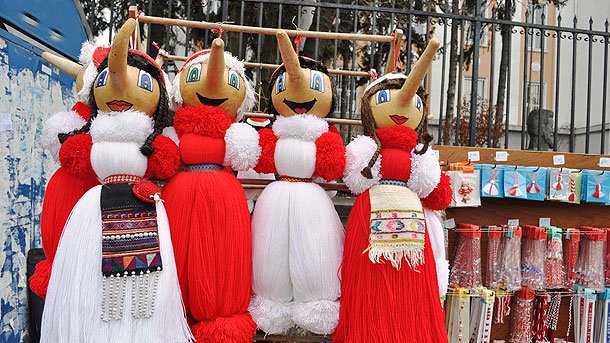The first harbingers of spring have filled the streets of Bulgarian towns and cities with vivid colors and sunny mood as early as the first days of February. The so-called martenitsas, small ornaments made of red and white yarn in numerous shapes and forms are sold at every street corner bringing smiles on the faces of passers-by. Everyone stops at the colorful street booths and stands to choose a beautiful adornment to give to friends and relatives.
The astronomic spring arrived on March 22, but in Bulgaria it arrives dressed in a red-and-white garment as early as March 1. On this day, Bulgarians give each other martenitsas – traditional Bulgarian ornaments made of red and white yarns. They are given to friends, relatives, family members and colleagues with wishes of health and happiness. People in the past also put them on their cattle.
An old legend goes that ancient Thracians used to welcome spring with a ritual similar to present-day martenitsa giving, and Orpheus himself is believed to have adorned his harp with one.
Nowadays, martenitsas are among the best recognizable Bulgarian symbols, and March 1 is one of the best-loved holidays in this country. This is one of the most joyous and optimistic days of the year, when Bulgarians say goodbye to cold and gloomy winter and look towards the warm and bright spring. People here start preparing for March 1 weeks earlier, taking strolls round street booths selling martenitsas of all kinds. Some people make their own martenitsas at home but the majority prefers to purchase them. The martenitsa market in Bulgaria has been really flooded this year, with martenitas imported even from China.

© Photo: Veneta Nikolova
In the past weeks, a campaign was launched for making the biggest martenitsa in Bulgaria, with many enthusiasts joining in to contribute. The campaign was also keenly accepted by Bulgarian nationals living abroad who were called on to send their martenitas by regular mail. The results will be made public on Bulgaria’s National Day, March 3, when the biggest martenitsa will be put on public display downtown Sofia, and everyone will be invited to tie a red-and-white tassel to it.
Pravda Ivanova from the youth section of Rotary Club Bulgaria, which is one of the organizers of the campaign, told Radio Bulgaria more:
“I believe that the martenitsa is a symbol universally recognized by Bulgarians around the world. We launched a special website called 3mart.suhranibulgarskoto.org, containing information on the campaign itself as well as instructions on how to prepare martenitsas at home.”
Every year on March 1, Bulgarians and especially children and young people walk in the streets wearing martenitsas of all kinds – the traditional type with the couple of Pijo and Penda (a male and female figure made of yarn), in the shape of bracelets, necklaces, earrings, rings, little toys, and even hats, all in red and white, the colors of joy and optimism.
Translated by: Rossitsa Petcova
From February 14 to 16, an event under the motto "Love and Wine" will allow Sofia residents and guests of the city to combine the Bulgarian holiday of wine Trifon Zarezan with Valentine's Day. It will be held on the pedestrian zone..
World Radio Day - 13 February, this year is dedicated to climate change. The choice is no coincidence—2025 has been identified by the Paris Agreement as a crucial year for humanity to achieve its long-term goal of limiting global warming to a maximum of..
“On 13 February this year, Bulgarian consumers must not shop at any of the grocery stores, at any of the chain stores, at any of the supermarkets! On 13 February grocery stores must be left empty, with not a single buyer in them,” the organizers..
Easter 2020 went down in history with two things. The first was the state of emergency, introduced due to the Covid-19 pandemic that..
152 years after the death of the Apostle of Freedom, the personality of Vasil Levski continues to excite Bulgarians, regardless of whether they are in the..

+359 2 9336 661
